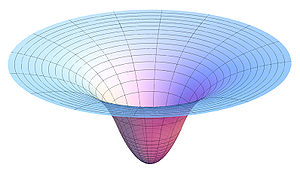Force field (physics)

In physics a force field is a vector field that describes a non-contact force acting on a particle at various positions in space. Specifically, a force field is a vector field , where is the force that a particle would feel if it were at the point .[1]
Examples
- In Newtonian gravity, a particle of mass M creates a gravitational field , where the radial unit vector points away from the particle. The gravitational force experienced by a particle of light mass m, close to the surface of Earth is given by , where g is the standard gravity.[2][3]
- An electric field is a vector field. It exerts a force on a point charge q given by .[4]
- A gravitational force field is a model used to explain the influence that a massive body extends into the space around itself, producing a force on another massive body.,[5]
Work
As a particle moves through a force field along a path C, the work done by the force is a line integral
This value is independent of the velocity/momentum that the particle travels along the path.
Conservative force field
For a conservative force field, it is also independent of the path itself, depending only on the starting and ending points. Therefore, if the starting and ending points are the same, the work is zero for a conservative field:
If the field is conservative, the work done can be more easily evaluated by realizing that a conservative vector field can be written as the gradient of some scalar potential function:
The work done is then simply the difference in the value of this potential in the starting and end points of the path. If these points are given by x = a and x = b, respectively:
See also
References
- ^ Mathematical methods in chemical engineering, by V. G. Jenson and G. V. Jeffreys, p211
- ^ Vector calculus, by Marsden and Tromba, p288
- ^ Engineering mechanics, by Kumar, p104
- ^ Calculus: Early Transcendental Functions, by Larson, Hostetler, Edwards, p1055
- ^ Geroch, Robert (1981). General relativity from A to B. University of Chicago Press. p. 181. ISBN 0-226-28864-1., Chapter 7, page 181
External links
- Conservative and non-conservative force-fields, Classical Mechanics, University of Texas at Austin












